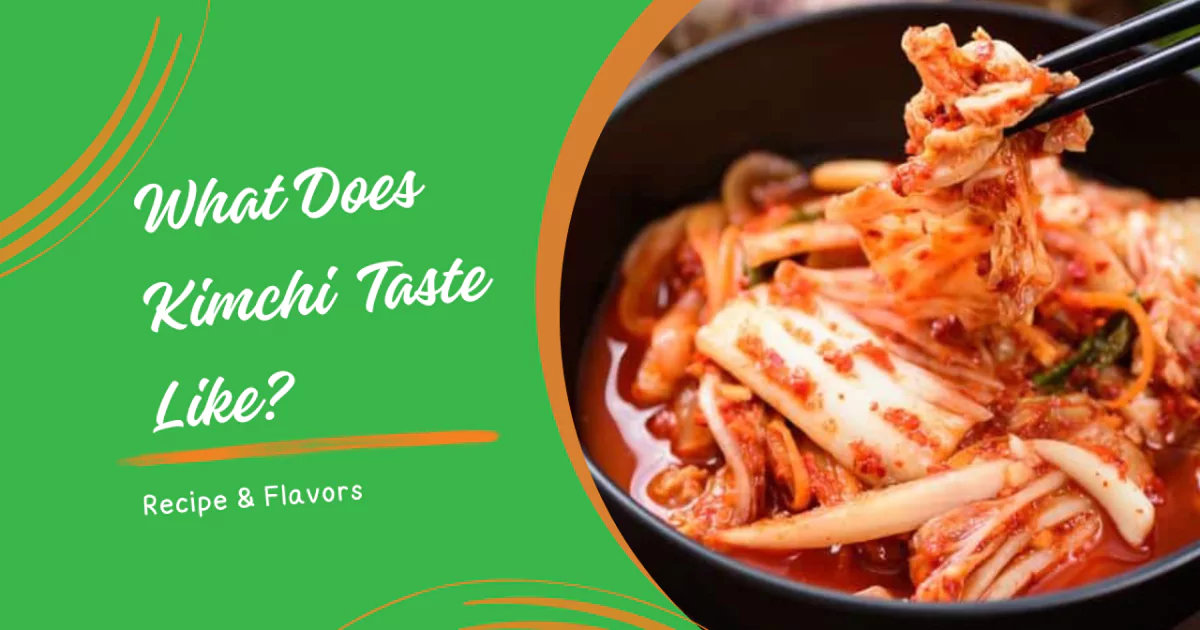Kimchi is a traditional Korean dish that has gained popularity worldwide for its unique and distinct flavor. It is a staple in Korean cuisine and is often served as a side dish or used as an ingredient in various dishes. If you have never tried kimchi before, what does kimchi taste like?
Therefore, this article covers all the essential information you need to know related to kimchi. Stick to the end and see how you can make this at home and what other options you can try with this.
So, without delving into further details, let’s hit the topic!
What Is Kimchi?

Kimchi is a traditional Korean side dish made from fermented vegetables, most commonly cabbage and radishes, along with a variety of seasonings. It is known for its distinct tangy and spicy flavor.
The process of making kimchi involves salting the vegetables to draw out moisture, then mixing them with a paste made from ingredients such as chili pepper flakes, garlic, ginger, and fish sauce. The mixture is then left to ferment for some time, allowing the flavors to develop and the beneficial bacteria to thrive. Kimchi is not only a staple in Korean cuisine but also renowned worldwide for its unique taste and health benefits, as it is rich in vitamins, minerals, and probiotics.
What Does Kimchi Mean?
The word “kimchi” itself refers to the process of preserving vegetables through fermentation. It is an integral part of Korean cuisine known for its spicy and tangy flavor. Kimchi is not only a delicious side dish but also a source of probiotics and vitamins. It has a long history in Korean culture and is often enjoyed with rice or used as an ingredient in various dishes such as stews, soups, and fried rice.
What Does Kimchi Taste Like?
People have many questions regarding kimchi. They are baffled. Does kimchi taste like vinegar, or does kimchi taste like sauerkraut? Kimchi is a traditional Korean side dish made from fermented vegetables, most commonly cabbage and radishes, along with a variety of seasonings. It has a unique and complex flavor profile that can be described as tangy, spicy, salty, and slightly sour. The fermentation process gives kimchi its distinct taste, as well as its signature intense aroma. The combination of the different ingredients and spices used in making kimchi creates a harmonious balance of flavors that is both refreshing and bold. The taste of kimchi can vary depending on the recipe and the length of fermentation, but overall, it offers a delightful explosion of flavors that is both savory and addictive.
How Is Kimchi Made?
The process begins by soaking the cabbage in salt water to remove excess moisture and create an environment conducive to fermentation. After rinsing the cabbage, it is mixed with a paste made from ingredients such as chili pepper flakes, garlic, ginger, fish sauce, and salted shrimp. This mixture is then packed tightly into a jar or container and left to ferment at room temperature for several days or weeks. During the fermentation process, lactic acid bacteria naturally present in the vegetables convert sugars into lactic acid, which gives kimchi its distinctive tangy flavor. The longer kimchi ferments, the more complex its flavors become. Once the desired level of fermentation is achieved, kimchi can be stored in the refrigerator for several months. It is commonly consumed as a side dish or used as an ingredient in various Korean dishes.
How To Make Kimchi?
Here is how you can make kimchi. This step-by-step guide covers all you need to know:
Ingredients:
One large napa cabbage
1/2 cup sea salt
4 cups water
One tablespoon of grated ginger
Four cloves garlic, minced
One tablespoon sugar
Three tablespoons of fish sauce (or soy sauce for a vegetarian version)
Two tablespoons Korean red pepper flakes (gochugaru)
Four green onions, chopped
1 medium carrot, julienned
Instructions:
Prepare the Cabbage
- Cut the cabbage in half lengthwise, then cut each half into quarters.
- Remove the core from each quarter and chop the cabbage into bite-sized pieces.
- Rinse the cabbage thoroughly under cold water to remove any dirt or impurities.
- Place the cabbage in a large bowl and sprinkle it with sea salt.
- Massage the salt into the cabbage leaves, ensuring they are evenly coated.
- Let the cabbage sit for about 2 hours, turning it occasionally.
Make the Brine
- In a separate bowl, combine water and sea salt to create a brine solution.
- Stir until the salt is completely dissolved.
Rinse and Soak the Cabbage
- After 2 hours, rinse the cabbage under cold water to remove excess salt.
- Drain the cabbage well and return it to the large bowl.
- Pour the brine over the cabbage, making sure it is fully submerged.
- Place a plate or a weight on top of the cabbage to submerge it.
- Let the cabbage soak in the brine for 2-4 hours.
Prepare the Seasoning Paste
- In a small bowl, combine grated ginger, minced garlic, sugar, fish sauce (or soy sauce), and Korean red pepper flakes.
- Mix well until all the ingredients are thoroughly combined.
Mix the Cabbage with Seasoning Paste
- Drain the cabbage from the brine, reserving some of the brine for later use.
- Add the seasoning paste to the drained cabbage.
- Put on a pair of disposable gloves and mix everything, ensuring each piece of cabbage is coated with the seasoning paste.
- Add chopped green onions and julienned carrots to the mixture and mix well.
Fermentation
- Transfer the kimchi mixture into clean glass jars or fermentation crocks.
- Press down on the kimchi to remove any air bubbles and ensure that it is tightly packed.
- Pour some of the reserved brine over the kimchi to cover it completely.
- Leave about an inch of headspace at the top of each jar or crock to allow for expansion during fermentation.
- Seal the jars or containers tightly.
Ferment and Store
- Place the jars or crocks in a cool and dark place, such as a pantry or basement.
- Let the kimchi ferment for 2-5 days at room temperature, depending on your preference for taste and texture.
- Check on the kimchi daily and press it down with a clean spoon to release any trapped gasses.
- Once fermented to your liking, transfer the jars or crocks to the refrigerator.
- The kimchi can be consumed immediately, but it will continue to ferment and develop more flavor over time.
Is Kimchi Good For Weight Loss?
Kimchi can be a beneficial addition to a weight loss diet due to its low-calorie content and high nutritional value. This traditional Korean side dish is primarily made from fermented cabbage, which is low in calories and high in fiber. The fermentation process also enhances the bioavailability of nutrients, making them more accessible for the body to absorb. Additionally, kimchi contains various vitamins, minerals, and antioxidants that can support overall health and weight management.
However, it is essential to note that the effectiveness of kimchi for weight loss depends on various factors such as portion control, overall dietary pattern, and physical activity levels. Incorporating kimchi into a balanced diet and other healthy lifestyle choices can contribute to weight loss efforts.
How Much Kimchi Should I Eat Per Day?
There is no specific recommended daily kimchi intake, as it varies depending on individual preferences and dietary needs. However, incorporating kimchi into your diet can provide various health benefits due to its rich content of vitamins, minerals, and probiotics. It is generally safe to consume kimchi in moderation as part of a balanced diet. It is important to note that kimchi is typically high in sodium, so individuals with high blood pressure or other health conditions should be mindful of their intake.
Additionally, you are new to consuming kimchi. In that case, it is advisable to start with small portions and gradually increase the amount to allow your body to adjust to the fermented flavors. As with any food, it is always best to listen to your body and consult a healthcare professional or nutritionist for personalized advice.
How Long Does Kimchi Last?
On average, homemade kimchi can last for about 3 to 6 months when stored in the refrigerator at temperatures below 40°F (4°C). The fermentation process helps preserve the kimchi by creating an acidic environment that inhibits the growth of harmful bacteria.
However, it is essential to note that the flavor and texture of kimchi may change over time, becoming more sour and softer as it continues to ferment. Commercially produced kimchi often contains preservatives and may have a longer shelf life, typically up to one year or more. It is crucial to check the label or packaging for specific storage instructions and expiration dates.
Can You Eat Kimchi While Pregnant?
Yes, it is generally safe to eat kimchi while pregnant. Kimchi is a traditional Korean fermented vegetable dish rich in vitamins, minerals, and probiotics. However, it is crucial to consume kimchi in moderation and ensure it is properly prepared and stored to avoid potential risks. Pregnant women should be cautious about the quality and hygiene of the kimchi they consume, as improperly fermented or contaminated kimchi may pose a risk of foodborne illnesses.
Also Read: How Much Pineapple Juice Will Cause A Miscarriage?
Additionally, some pregnant women may experience heartburn or digestive discomfort after consuming spicy foods like kimchi, so it is advisable to listen to your body and adjust your intake accordingly. As always, it is recommended to consult with a healthcare professional for personalized advice regarding your specific dietary needs during pregnancy.
Vegan Recipes With Kimchi
Here are two best vegan recipes with kimchi you can easily make at home if you are unable to find any best store-bought kimchi:
Vegan Kimchi Fried Rice Recipe
Ingredients:
- 2 cups cooked rice
- 1 cup vegan kimchi, chopped
- 1/2 cup firm tofu, diced
- 1/2 cup carrots, diced
- 1/2 cup peas
- Three cloves garlic, minced
- Two tablespoons soy sauce or tamari
- One tablespoon of sesame oil
- One tablespoon of vegetable oil
- Green onions, sliced (for garnish)
Instructions:
- Heat vegetable oil in a large skillet or wok over medium heat.
- Add minced garlic and sauté for about a minute until fragrant.
- Add diced tofu and cook until lightly browned on all sides.
- Stir in the carrots and peas, and cook for 2-3 minutes until slightly tender.
- Add the vegan kimchi to the skillet and stir-fry for 2 minutes.
- Push the ingredients to one side of the skillet and add sesame oil to the space.
- Add the cooked rice to the skillet and drizzle with soy sauce or tamari.
- Mix everything until well combined and heated through.
- Remove from heat and garnish with sliced green onions.
- Serve hot, and enjoy!
Vegan Kimchi Pancakes Recipe
Ingredients:
- 1 cup all-purpose flour
- 1 cup water
- 1/2 cup vegan kimchi, chopped
- 1/4 cup green onions, chopped
- Two tablespoons flaxseed meal mixed with six tablespoons water (flax egg)
- One tablespoon of soy sauce or tamari
- One tablespoon of sesame oil
- Vegetable oil for frying
Instructions:
- In a mixing bowl, combine the all-purpose flour, water, flaxseed meal mixture, soy sauce or tamari, and sesame oil. Whisk until smooth.
- Add the chopped vegan kimchi and green onions to the batter and mix well.
- Heat a non-stick skillet or frying pan over medium heat and add a small amount of vegetable oil.
- Pour a ladleful of the batter onto the skillet, spreading it into a thin pancake.
- Cook for about 2-3 minutes on each side until golden brown and crispy.
- Repeat with the remaining batter, adding more oil to the skillet as needed.
- Once cooked, transfer the pancakes to a plate lined with paper towels to absorb any excess oil.
- Serve hot with a dipping sauce of your choice, such as soy sauce or tamari mixed with rice vinegar and sesame oil.
Conclusion
In conclusion, kimchi is a unique and flavorful dish that offers a complex taste profile. Its primary flavors include spicy, sour, and umami notes. The fermentation process gives kimchi its distinct tanginess and depth of flavor. The spiciness can vary depending on the recipe and personal preference, ranging from mild to fiery.
Additionally, the texture of kimchi can be crunchy or soft, depending on the ingredients used and the length of fermentation. Overall, kimchi is a versatile condiment that adds a burst of flavor to any dish, making it a beloved staple in Korean cuisine.
Frequently Asked Questions (FAQ’s)
Is Kimchi Healthy?
Kimchi is a traditional Korean dish made from fermented vegetables, such as cabbage and radishes, which are rich in vitamins, minerals, and beneficial bacteria. It is considered healthy due to its probiotic properties, high fiber content, and various nutrients.
What Does Kimchi Smell Like?
Kimchi has a pungent and distinct smell that is often described as sour, tangy, spicy, and fermented. It can vary in intensity depending on the ingredients used and the fermentation process.
Is Kimchi Spicy?
Kimchi is a traditional Korean dish that is typically spicy, although the level of spiciness can vary depending on the recipe and personal preference.
Is Kimchi Good For You?
Yes, it is good for you as it can improve digestion, boost the immune system, promote weight loss, and provide various other health advantages.
What To Eat Kimchi With?
Kimchi can be enjoyed with a variety of dishes such as rice, noodles, soups, stews, and even sandwiches. It is a versatile condiment that adds a tangy and spicy flavor to any meal.






